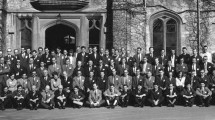Abstract
RECENT work on the electron spin resonance signals observed in ultra-violet-irradiated proteins1 has stimulated interest in the theory that proteins may exhibit conduction band properties. In experiments with ultra-violet irradiated proteins and amino-acids carried out in this laboratory, results have been obtained which in a particular instance may support such a theory.
Similar content being viewed by others
References
Allen, B. T., and Ingram, D. J. E., Free Radicals in Biological Systems, edit. by Blois, M. S., 215 (Academic Press, 1961).
Windle, J. J., Text. Res. J., 32, 963 (1963).
Beaver, G. H., and Holiday, E. R., Adv. in Protein Chem., 7, 312 (1952).
Bogle, G. S., Burgess, V. R., Forbes, W. F., and Savige, W. E., Photochem. and Photobiol., 1, 277 (1962).
Dunlop, J. I., and Nicholls, C. H. (submitted for publication).
Szent-Györgyi, A., Nature, 148, 157 (1941).
Gergely, J., and Evans, M. G., Biochim. Biophys. Acta, 3, 188 (1949).
Author information
Authors and Affiliations
Rights and permissions
About this article
Cite this article
DUNLOP, J., NICHOLLS, C. Unpaired Electrons in Ultra-violet-irradiated Keratin. Nature 205, 1310–1311 (1965). https://doi.org/10.1038/2051310a0
Issue Date:
DOI: https://doi.org/10.1038/2051310a0
- Springer Nature Limited





